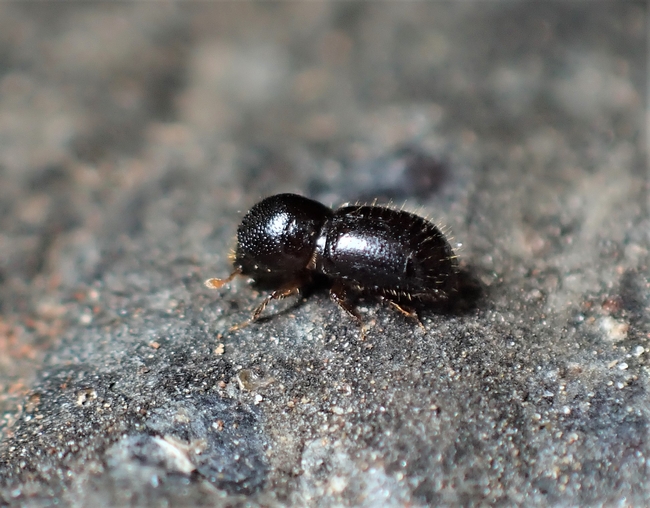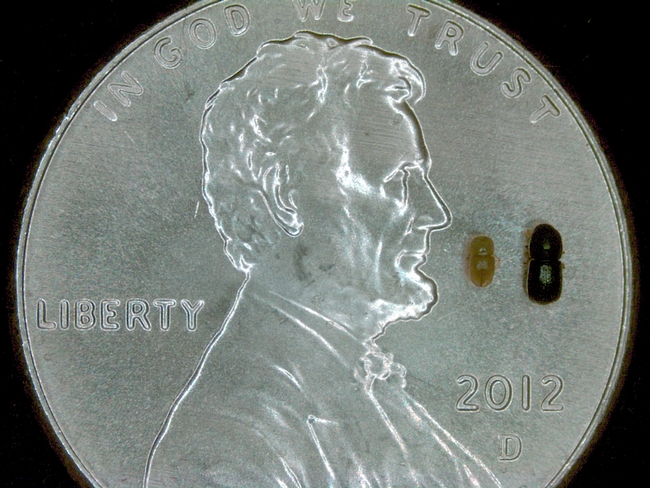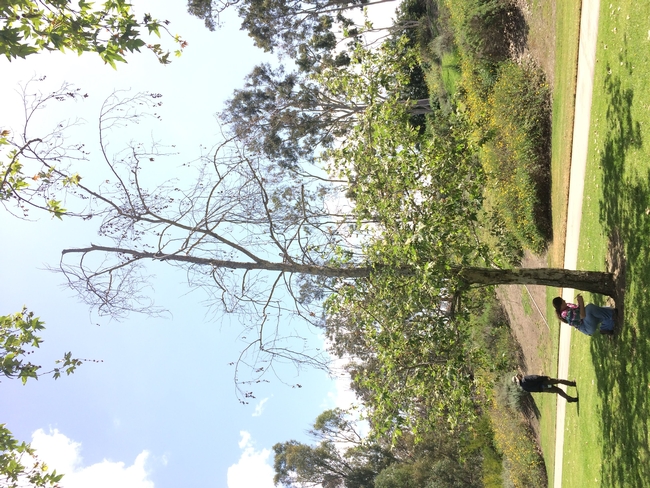Posts Tagged: Pest Management
UC ANR experts, resources guide response to shothole borers in Bay Area
UC Cooperative Extension scientists, partners managed invasive beetle in Southern California
Late in 2023, a potentially devastating beetle was detected in the San Francisco Bay Area for the first time. But land managers, arborists and agency staff have one big advantage as they devise plans to control the invasive shothole borers (ISHB).
Thanks to collaborations led by University of California Agriculture and Natural Resources, they can draw upon the hard-earned experience of their colleagues in Southern California. Over the past decade, SoCal communities have lost “tens of thousands” of trees due to ISHB infestations, according to Beatriz Nobua-Behrmann, UC Cooperative Extension urban forestry and natural resources advisor for Los Angeles and Orange counties.
In one regional park, about 500 trees had to be removed in the span of just one year. “That kind of impact happened in many locations; a whole street might lose 90% of the trees – all of a sudden,” said Nobua-Behrmann, a member of a statewide network studying ISHB.
Spurred by such severe impacts, UC scientists have been studying ISHB and testing various control measures since about 2012. Their lessons are now informing efforts in San Jose – where the first case in the Bay Area was detected in November 2023 – and across the region.
“The UC ANR team is comprised of subject-matter experts,” said Drew Raymond, interim agricultural commissioner for Santa Clara County. “The team has compiled all of the experience from the agencies that have been doing work in Southern California and transplanted that experience here to Northern California.”
Lucy Diekmann, UC Cooperative Extension urban agriculture/food systems advisor, and Igor Lacan, UCCE environmental horticulture and urban forestry advisor, have coordinated regular meetings and trainings of Bay Area agricultural officials, land managers and arborists.
“Lucy and Igor have been instrumental in organizing our partners to establish an effective plan for shothole borers,” said Sara Davis, city forester for San Jose. “Because experts across the broader UC ANR network have many years of firsthand experience with this invasive pest, we are able to draw on their practical know-how to guide our monitoring, management and public education efforts.”
Davis is leading a trapping program in San Jose to determine how widespread ISHB is. Aside from a recent detection in the Santa Cruz Mountains, almost all of the approximately 30 confirmed cases in Northern California have been clustered along the riparian corridor of Coyote Creek through downtown San Jose. This pattern of intense but geographically limited damage was also seen across Southern California – notably in San Diego County along the Tijuana River Valley, where ISHB wiped out the willow population.
“I would expect us in the Bay Area to see this type of localized damage that is not fundamentally different from what they're seeing in Southern California,” Lacan said.
Unusually troublesome pest triggers deadly tree disease
The invasive shothole borers – a term for two species that are virtually indistinguishable, the polyphagous shothole borer and Kuroshio shothole borer – were first detected in Los Angeles in 2003. The tiny beetles, measuring 1.5 to 2 millimeters in length, became a major concern a decade later when swaths of urban forest began dying across LA County.
Infestations are harmful – and fatal for at least 17 tree species in California – because the fungus that the beetle “farms” as its food source causes a disease called Fusarium dieback. Alarmingly, ISHB make their home in a wide variety of trees; Nobua-Behrmann said 65 tree species in California have been identified as “reproductive hosts” where they can grow their populations.
“The fact that they are such a generalist species means that they can find a host almost anywhere,” she said, noting that sycamore, box elder, cottonwoods, oaks and willows are favorites of ISHB.
Furthermore, typical tools in the integrated pest management toolbox are unavailable or ineffective for this invasive beetle. Unlike most insects, these shothole borers mate with their siblings before leaving the tree, so they don't need to search for mates afterward. This means they are not attracted to the pheromone traps typically used for pest control; traps used for ISHB only work to track their numbers, not reduce them.
“Their biology limits what we can do,” Nobua-Behrmann said. “Since the beetles spend most of their lives inside the trees, it's also hard to reach them with insecticides.”
Largely hidden within trees, ISHB can build up their numbers, undetected for years. A tree with green and plentiful leaves may in fact be harboring a significant infestation. “It's easy for this beetle go under the radar and create a big population and a big problem before you even notice,” Nobua-Behrmann said.
Monitoring and early identification of infestations are crucial
Given this pest's elusive nature, monitoring and early intervention have proven to be essential in Southern California.
“All of the success stories have a major component of monitoring and detection; if you have a good monitoring program and you can quickly identify the trees that are infested, timely action can make a big difference,” said Nobua-Behrmann, citing Disneyland in Anaheim as one example where frequent surveys and robust monitoring prevented major impacts.
As most municipalities don't have the abundant resources of a world-famous theme park, Nobua-Behrmann pioneered a program in Southern California to train community members on recognizing telltale signs of the beetle. Specifically, they looked for its entry holes, which have a characteristically round shape and size, comparable to the tip of a ballpoint pen.
Beginning with UC Master Gardeners and UC California Naturalists and then members of the general public in LA and Orange counties (and later other SoCal counties), the program trained about 100 people on how to look out for the beetle. After verification by experts, volunteers were found to be nearly 90% accurate in identifying ISHB.
Although the volunteer monitoring program is on hiatus, Nobua-Behrmann said it had clear benefits that could potentially help other regions. “It would be great to get this program going in Northern California and hopefully get volunteers and people in the general public to help identify infestations there as well,” she said.
Statewide ISHB network spreads essential information
In addition to coordinating an in-person public training in San Jose in April, Lacan and Diekmann, the UC Cooperative Extension advisors, have been educating local UC Master Gardeners on how to spot signs of the invasive beetle.
For about a decade, Lacan has been warning people about the possibility of ISHB in Northern California, routinely including shothole borers in his presentations on “tree pests to watch.” “I've been doing this since before ‘day zero,' but there was not a whole lot of interest in ISHB, as you might imagine,” Lacan recalled. “But then all of that changed in fall of last year.”
In the past year, Lacan has done a dozen ISHB presentations, workshops and webinars, attended by a total of about 260 people – predominantly city foresters, land managers, production arborists and members of tree-related nonprofits.
Lacan noted that the most effective presentations have been at in-person events featuring UC ANR-affiliated experts such as Nobua-Behrmann, UCCE environmental horticulture advisor emeritus John Kabashima, and ISHB program staff Randall Oliver and Hannah Vasilis.
“Here is where we tap into our network,” Lacan said. “This is the power of the statewide shothole borers program.”
Another vital asset has been the collection of practical resources gathered by the ISHB program, the UC Integrated Pest Management team and partner organizations. One example is a deck of identification cards depicting how symptoms of infestation differ from species to species. Such detailed information can help managers determine whether a tree is truly infested – and thus allocate their limited resources more judiciously.
“These very specific, very seriously considered materials are the kind of thing that people really appreciate,” Lacan said. “It's not just a generic ‘it's kind of like this.'”
The symptoms, broken down by tree species, are also listed on the ISHB website. Raymond, the interim agricultural commissioner for Santa Clara County, said his team uses the website to get informed about ISHB and regularly refers community members to it.
“The ISHB website has been a great resource,” Raymond said. “It's full of important and user-friendly information.”
Communities learn to protect trees, adapt to shothole borers
If community members believe a tree is infested, they should review the symptoms of ISHB-Fusarium dieback. If the signs match what they are seeing, they should take a photo of the entry hole (with the tip of a ballpoint pen placed next to the hole as reference) and send images to their county agricultural commissioner's office or local UCCE advisor, who may then seek confirmation.
Extra eyes on urban forests are crucial to help experts identify potential “amplifier trees” – heavily infested trees, with more than 150 entry holes, that are often repeatedly reinfested by subsequent generations of beetles. They contribute to the recurring pattern of severe but localized infestations seen across Southern California – and now in San Jose.
New research suggests that removing severely infested trees – or just the most impacted limbs of those trees – can significantly lower the overall ISHB population and help less-infested trees in the area recover over time.
“You're not going to eradicate ISHB (at least not in Southern California); you're not going to get rid of them – you're going to have them forever,” Nobua-Behrmann said. “But you can keep them at a manageable amount.”
She also emphasized other actions the public can take to prevent the spread of ISHB, such as correctly disposing infested plant material – ideally chipping it to less than an inch in length (or as small as possible) and then composting the chips.
“It's also important to not move firewood and instead buy it where you will be burning,” Nobua-Behrmann said. “It's one of the best things people can do to protect trees from invasive pests.”
After identifying and removing amplifier trees, land managers and landscape arborists should have a plan for replanting, Lacan added. He said they should prioritize species that are less susceptible to the beetle, using his Pest Vulnerability Matrix tool that lists the major pests for different mixes of trees.
“We need to figure out how to have sustainable urban forests, even with this pest,” he said. “We know we can do it, largely thanks to our colleagues in Southern California. So the key lesson is to replant soon – choose smartly, but replant right away.”
The Beautiful Coloration of a Western Yellowjacket
It's been several months since I've seen a Western yellowjacket, Vespula pensylvanica. But there it was, dead. It had drowned in an...
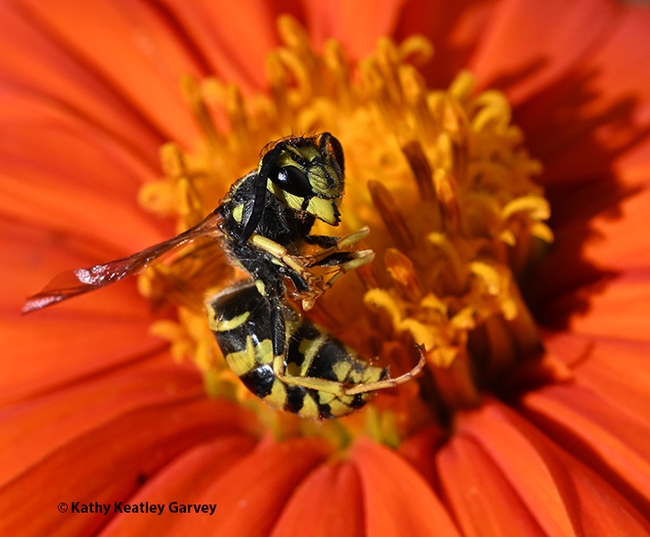
A yellowjacket (expired) placed on a Mexican sunflower, Tithonia rotundifola. (Photo by Kathy Keatley Garvey)
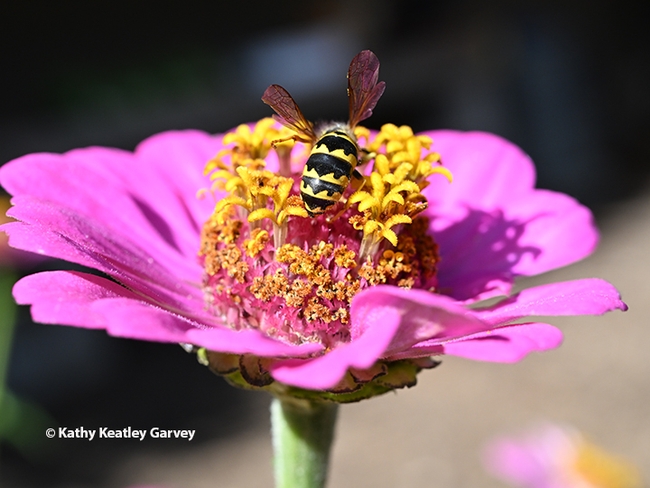
The black and yellow coloration of the yellowjacket is striking. (Photo by Kathy Keatley Garvey)
International Insect Salon's Amazing Images
If you love capturing images of insects or admiring the images of other photographers, you'll want to access the 66th annual International...

Kwong Ying Au-yeung of Hong Kong won best of show in the International Insect Salon with this image of a robber fly and prey. (Screen shot from International Insect Salon)

This image by Joseph Spencer of Thomasboro, Ill., won the medal for best image by an ESA member in the International Insect Salon. He titled it "Cloudless Sulphur on Thistle." (Screen shot from the International Insect Salon)

Dan Osipov of Danville, Calif., won a honorable mention in the International Insect Salon competition with this image that he titled "Glasswings." Only two California photographers had images accepted. (Screen shot from International Insect Salon)
Walter Leal: The Energizer Bunny at Full-Industrial Strength
When Walter Leal submitted his application in 2000 to join the faculty at the University of California, Davis, one of his references wrote "He...

UC Davis distinguished professor Walter Leal delivering a substitute lecture when entomologist May Berenbaum was unable to attend to present the Wigglesworth Memorial Award Lecture.

UC Davis distinguished professor Walter Leal with former members of the UC Davis Leal lab at ICE2024. From left are Wei Xu, Yuko Ishida, Zain Syed, Walter Leal, Fen Zhu, and J-J Zhou.
Don't Miss This UC Davis Seminar by Ecology Researcher Andrew Corbett
Don't miss this UC Davis Department of Entomology and Nematology (ENT) seminar by ecologist Andrew Corbett, a research associate with ENT...

Ecologist Andrew Corbett, who holds a doctorate in ecology (joint program with UC Davis and San Diego State University) will present a seminar at 4:10 p.m., Oct. 21 in 122 Briggs Hall, UC Davis. It also will be on Zoom.



